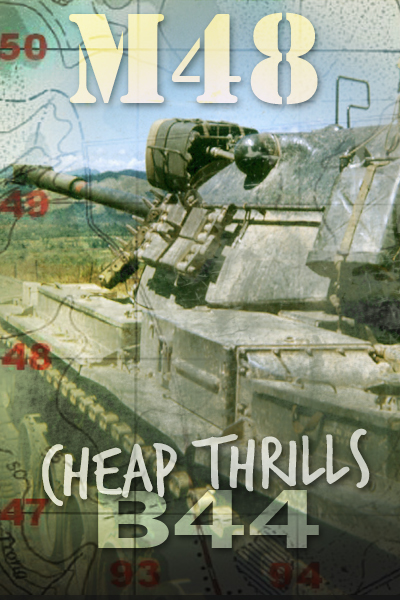 The Vietnam War formally began in September of 1959, with the arrival of American advisers, though the strength in numbers for the American combat forces did not occur until around 19656. The M48 was the mainstay of the American armored forces at the time and the Patton become the heaviest tank to be fielded by the US Army during the conflict. Despite her armor protection and suitable main gun, the M48 was thrown into a war for which it was not directly intended. While expecting to face off head-to-head against North Vietnamese and Viet Cong armor in tank-versus-tank duels, the M48 was relegated to supporting infantry actions in the dense jungle and suburban fighting to follow. Six hundred Pattons would see service. The first was attached to the USMC 1st and 3rd Tank Battalions arriving in 1965. Cavalry squadrons would eventually replace their heavy M48’s with the lighter, M551 Sheridan.
The Vietnam War formally began in September of 1959, with the arrival of American advisers, though the strength in numbers for the American combat forces did not occur until around 19656. The M48 was the mainstay of the American armored forces at the time and the Patton become the heaviest tank to be fielded by the US Army during the conflict. Despite her armor protection and suitable main gun, the M48 was thrown into a war for which it was not directly intended. While expecting to face off head-to-head against North Vietnamese and Viet Cong armor in tank-versus-tank duels, the M48 was relegated to supporting infantry actions in the dense jungle and suburban fighting to follow. Six hundred Pattons would see service. The first was attached to the USMC 1st and 3rd Tank Battalions arriving in 1965. Cavalry squadrons would eventually replace their heavy M48’s with the lighter, M551 Sheridan.
When the US forces were not suppressing the enemies by way of the main cannon or machine gun fire, they were shredding them by way of the canister round. This 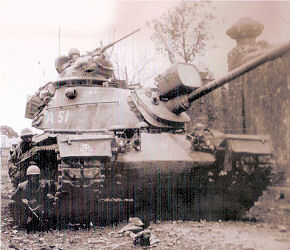 destructive projectile essentially turned the main gun of the M48 into a large spread-fire shotgun, dispersing some 1280 pellets or 10,000 darts against infantry or to cut way thickets of the jungle. Beyond the base M48 tank system, the flamethrower derivative, the M67A1 “Zippo” was heavily featured. When all was said and done, the M48 proved its worth in the conflict, offering adequate crew protection and heavy direct firepower.
destructive projectile essentially turned the main gun of the M48 into a large spread-fire shotgun, dispersing some 1280 pellets or 10,000 darts against infantry or to cut way thickets of the jungle. Beyond the base M48 tank system, the flamethrower derivative, the M67A1 “Zippo” was heavily featured. When all was said and done, the M48 proved its worth in the conflict, offering adequate crew protection and heavy direct firepower.
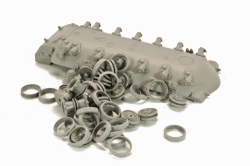
|
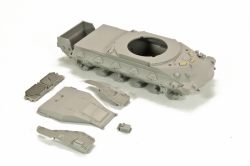
|
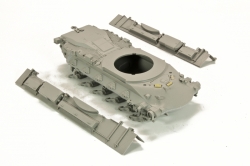
|
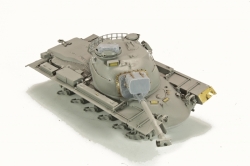
|
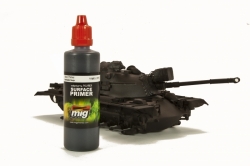
|
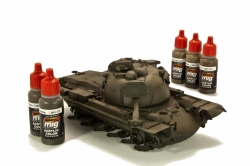
|
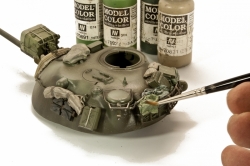
|
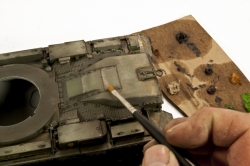
|
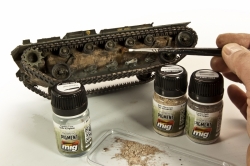
|
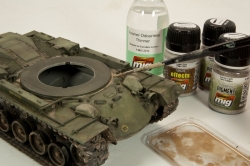
|
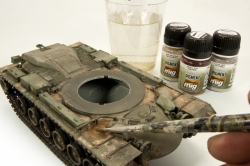
|
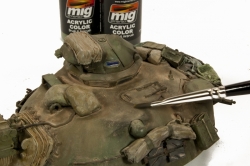
|
When it came to the painting on this vehicle I tried to remain true to the photos I was using as references. Not a lot of chips and scratches, but lots of dust and dirt buildup. Vietnam, it seems, is equal parts hot and dusty mixed with wet and muddy. The result – filthy surfaces. The challenge, I believe, when doing a heavily weathered (muddy) vehicle is to maintain a sense of balance – or proportion. It’s all too easy to simply slop on a load of plaster powder, paint, pigments, and enamel spatter – and while it might serve the purpose of portraying a muddy vehicle it loses all sense of visual interest.
Balance and proportion, in the case of modeling, means that we still must show restraint – the ideal is always the same – create visual interest for the viewer. To this end, it is important to create areas of heavy and lighter 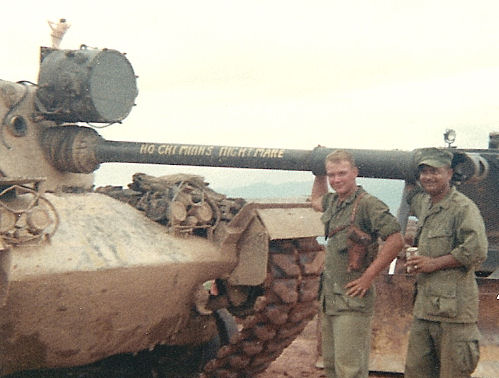 accumulations, darker mud and lighter dust, dry and damp surfaces; all tempered between the notions of artistic license and realism. That, in my opinion, is a tough sell. Did I meet my expectations for this particular project – not really. In my opinion, I missed the mark – not in big ways, but in a number of little instances that when combined leave me with a sense of “what could have been”. But, as they say, “there is always next time!” So why, might you ask would I post something that I wasn’t entirely satisfied with? The answer is simple; this space is about my work – all of it (well, most of it) – which means that I show not only the projects that met or exceeded my expectations but also those that fell short. Remember (get ready…another cliche’), it’s the journey, not the destination.
accumulations, darker mud and lighter dust, dry and damp surfaces; all tempered between the notions of artistic license and realism. That, in my opinion, is a tough sell. Did I meet my expectations for this particular project – not really. In my opinion, I missed the mark – not in big ways, but in a number of little instances that when combined leave me with a sense of “what could have been”. But, as they say, “there is always next time!” So why, might you ask would I post something that I wasn’t entirely satisfied with? The answer is simple; this space is about my work – all of it (well, most of it) – which means that I show not only the projects that met or exceeded my expectations but also those that fell short. Remember (get ready…another cliche’), it’s the journey, not the destination.
UPDATE:
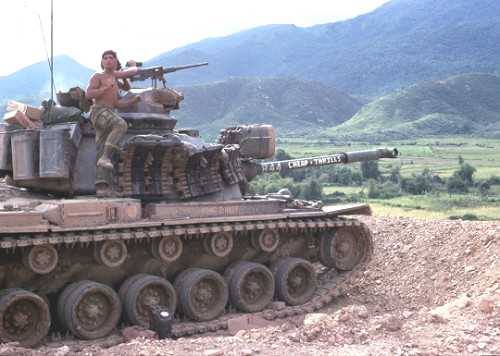
Since the posting of this article, I received a comment from Mr. Ken Jellerson, USMC ret., who mentioned in brief that the tank “Cheap Thrills” was the vehicle he had served on during his tour in Vietnam. I quickly wrote back to Mr. Jellerson, asking if he might have any additional information about his service to the vehicle. The next day I received a very nice email in which Mr. Jellerson summarizes his experiences. To receive this letter, to put real-life context to the models that we build is an amazing experience. I would like to extend my heartfelt thanks to Sgt. Jellerson for his service, and for his willingness to take his time to share his experiences.
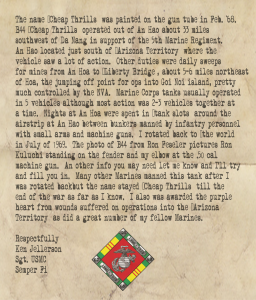 Another Update:
Another Update:
After being contacted by Mr. Jellerson, I was contacted by Mr. Quackenbush who offered these insights:

was the marine that named this tank ‘cheap thrills’ I painted the name on the gun tube in early 1969